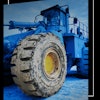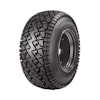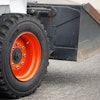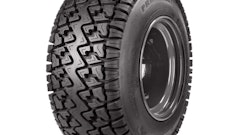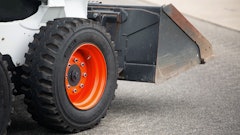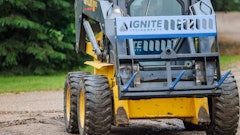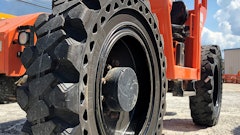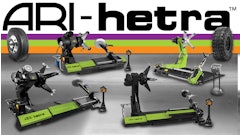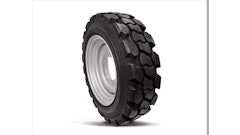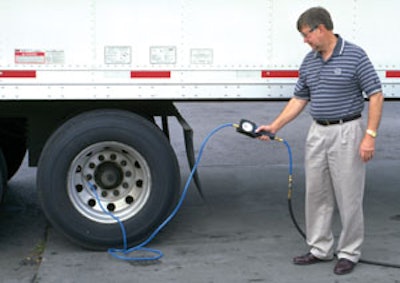
Tire cost is the second largest contractor vehicle expense after fuel, so it makes sense to protect your tires from unnecessary wear and reuse them when you can. The following tips can help ensure your tires are getting proper care, which will result in extended tire life, maximum efficiency, and lower tire costs.
Keep an eye on pressure
"The number one issue for any fleet is inflation pressure," says Al Cohn, technical marketing manager at Goodyear Tire Company. "Air is what carries the load. If you have low air pressure, your tires will run hot, you'll have traction issues, the tires will wear unevenly, and your fuel economy will decrease."
Running a tire with less air than recommended forces a tire to work harder than what it was designed to do. The tire flexes more, overheats, and breaks down internally. This will result in premature removal or even tire failure. Cohn says that running a tire that is 20% underinflated will result in 16% fewer miles to removal.
Underinflation isn't the only pressure-related threat to tire life. Avoid overinflation, too. Tires with high air pressure will give drivers an uncomfortable, bouncy ride and will develop excessive centerline wear, also resulting in early removal.
Guy Walenga, engineering manager for North American commercial products at Bridgestone Firestone North American Tire LLC, has some suggestions for checking air pressure. "You shouldn't kick or hit a tire to check air pressure," he says. "A gauge is what you should use to check air pressure, and the pressure should be checked when the tires are cold, not hot. You want to use an accurate gauge. Stick gauges are relatively accurate, they're inexpensive, and to me they're throw aways. You use them for a while, and when they become inaccurate you throw them away."
Walenga says many maintenance shops have a master gauge — a relatively expensive, water-filled, accurate, adjustable air pressure gauge that's connected into the air system that the shop uses for its tools. Walenga suggests checking less expensive stick gauges often against a master gauge and replacing them when they lose accuracy. This eliminates the need for business owners to buy several expensive gauges for their crew members but still allows them to maintain accurate air pressure across their fleets.
Obey load limits
You get the same deteriorating effects running tires under an overloaded vehicle as you do running underinflated tires. The same idea applies — you're running too much weight on too little air. A tire is designed to carry a given load at a given air pressure. When this rule is broken, problems happen.
"You might have a tire that's designed to carry 6,000 pounds and you have enough air pressure to carry 6,000 pounds, but it becomes overloaded with 7,000 pounds. So the tires still don't have enough air to carry the load," Walenga says. "That fatigues the tires. It causes the tires to break down internally, little by little by little, every day."
Avoid unnecessary tread wear
Another thing to remember when striving for tire preservation and maintenance is application and tread selection. Different treads and tire constructions are created for different applications and even wheel positions. In order to get the most value out of a tire, you have to choose the right tire for the application you have in mind for it.
"If you have a highway design casing, tread, and compound and you go off-road with it, it is very unforgiving. It will cut, chip, look bad real fast, and wear out very quickly, because the tire isn't designed for the irregularities and the roughness of an off-highway operation," explains Walenga.
"Now, conversely, if you took tires designed for off-highway work, or construction-type tires, and you ran those tires on a line-haul application, they would run hot and wear out in a heartbeat because the compound isn't designed to run down a highway — it's designed to flex. As the tire flexes it scrubs, and as it scrubs it wears, so it's wearing at a faster rate than it should for a highway tire."
Retreading tires is a popular way to cut overall tire costs. About 85% of all fleets retread, at a savings of about one-third the cost of new tires.
If you plan to retread a tire, there are a couple of things to keep in mind. First, start out with a high quality tire. Second, you need to protect the casing. This means protecting it from heat build-up by ensuring proper tire inflation and not overloading the tire. Proper alignment will ensure an even tread wear.
"If the tire is not maintained properly then it probably will not live through its original life, let alone be durable enough for a retread," says Walenga.
"Fingertip diagnostics"
Cohn says drivers can have a big influence on tire care and maintenance. In addition to checking tire pressure weekly and regularly walking around a vehicle to visually assess tires, Cohn explains drivers should regularly perform something he calls "fingertip diagnostics."
"Drivers should run their hands across a tread," he says. "This way they can detect signs of wear or any uneven tread, which could indicate an alignment problem. They should also run their hands along the tire's sidewalls, checking for cracks and bulges."


